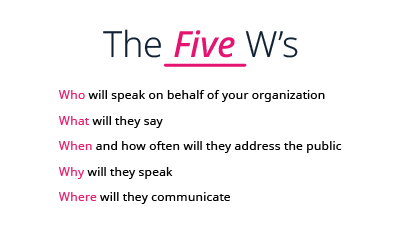The Ultimate PR Crisis Management Plan
You might ask, what exactly is crisis management? Simply put, it’s “the process of having a business continuity plan in place in the event of a crisis.” 1
Crises can range; one extreme example is COVID-19. The global pandemic caught businesses unprepared with no plan or strategy to navigate the changes. Organizations should be more equipped for internal crises though, in the event their servers get hacked, there’s an office fire, or private customer information is leaked.
Crisis management and communication aims to minimize the negative risk impacts and maximize the potential opportunities that times of difficulty often present.
In order to become a successful public relations manager, you need to include risk prevention and preparation in your crisis management strategy. Without this, threats will escalate to crises, and brands and businesses will potentially fail to save their reputations from becoming tarnished.
Want to become a valuable public relations manager?
The Public Relations (PR) online short course from the University of Cape Town (UCT) equips you with the latest PR management best practices for the digital age. Over the course of eight weeks, you’ll learn how to manage a brand, business, or individual, build influential relationships, and plan for crisis management.
Below are five key steps to setting up a crisis management plan:
1. Start your crisis management plan by identifying potential risks
- Identify potential crises for your brand
- Conduct an internal vulnerability audit
- List best-case/worst-case scenarios
- Develop holding statements and responses
- Practice social listening actively
- Locate customer dissatisfaction
2. Define your communication guidelines
Communication is key within a crisis. The future of work is changing to be more technology-heavy and that includes digital communication. As a PR professional you’ll need to navigate various platforms, channels, and audiences. Generally, be sure all messaging addresses:

By having these planned out ahead of time, you’ll be able to act swiftly in a crisis.
3. Have a set of key actions for implementing your crisis management plan
“It’s important that the organization is able to react fast and speak with one voice, which is difficult to achieve when multiple people begin to speak on its behalf,” says Evan Nierman, founder of Red Banyan, which specializes in strategic communications and crisis PR.2
In times of crisis, key actions include an ability to:
– Address perceptions. The gravity of a crisis is directly proportional to the public’s perception of it, rather than to what has actually happened.
– Listen to the people who are complaining. It’s very important to try to understand what is making people concerned before you address the issue.
– Tune in emotionally. You need to know how to interpret the public’s mood. Communication should not be treated as an impersonal means for spreading ideas.
– Reason from your client’s point of view. Make it clear that the company is defending the interests of the people it serves.
– Distinguish between law and public opinion. It’s best to have both legal advisers and communication experts on hand to determine what is right and what is legal.
4. Establish notification and monitoring systems
Be aware of conversations taking place online and in the media to understand what topics are being discussed and how they relate to your brand. Consistent monitoring allows you to see the crisis coming by always being on the lookout for it.
Figure out where the conversations are happening and address it there. If someone speaks up on a different platform, redirect them to where you’re talking about the crisis.
5. Identify and know your stakeholders
Campaigns and communication strategies depend on how involved stakeholders are in the process.
“Whatever the strategy is, the company must relay protocol to any and all persons who could be approached to speak on their behalf,” says Sabrina Gault, CEO of Konnect Public Relations. “This means informing all employees, stakeholders, board members, etc., of who is to be speaking with [the] media and how they are to direct any inquiries. This will save the company from having to explain comments from any unofficial company representatives later.” 3
As stakeholders will be discussing the matter with others, you want to ensure that they are well-prepared with a cohesive message to share.
6. Test, execute, and review your crisis management plan
Publicist Josh Wilson, former communications director in the U.S. House of Representatives, stresses the importance of having a plan and reviewing the details.4
“Company leaders should sit down and walk through likely crisis scenarios – and even highly unlikely ones – to avoid reputation damage. Planning is never a waste of time. Indeed, discussing how to handle a major event makes a fantastic team-building exercise,” Wilson says.
Constantly test your plan to ensure you have every potential crisis covered. Understand that your risk management strategy is a living, breathing document that you need to constantly adapt and rework. Start building a crisis strategy for your brand or business today.
Download this PR communication crisis template to prepare for a crisis.
- 1 Hayes, A. (Aug, 2021). ‘Crisis management’. Retrieved from Investopedia.
- 2 Caramela, S. (Dec, 2021). ‘PR crisis? 6 Steps to help navigate the storm’. Retrieved from Business News Daily.
- 3 Caramela, S. (Dec, 2021). ‘PR crisis? 6 Steps to help navigate the storm’. Retrieved from Business News Daily.
- 4 Wilson, J. (Jan, 2022). ‘The most common mistakes in crisis communication’. Retrieved from QualityDigest.
